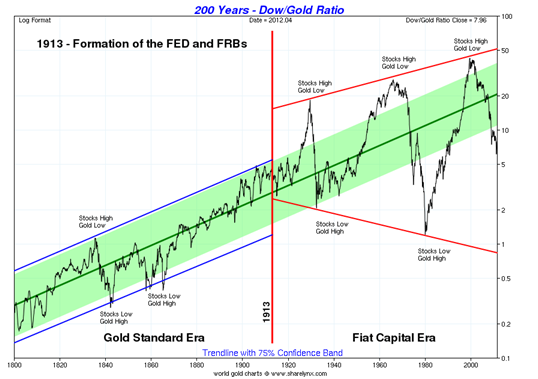We’ve thoroughly discussed the unhelpful practice of pricing assets in dollars. It’s a yardstick that changes length on a daily basis. And over any significant period of time, the price movement of gold, or oil, or cotton – anything – is misleading at best.
So it’s better and more useful to look at the relative price movement of different asset classes.
I like to use gold to price oil – for instance. Or I like to look at the broad stock market in comparison to the price of gold.
That kind of comparison effectively scrubs out the dollar in the denominator – and gives us a more pure look at the real story of supply, demand and price.
Gold is especially useful because there’s such a static supply of the stuff. It’s a kind of mirror that tells us the relative health of other assets.
In the past, I’ve discussed the Dow/gold ratio – that is, dividing the Dow Jones Industrial Average by the price of one ounce of gold.
Doing so gives us a much different view of what asset class is expensive or cheap – which is in decline or growth.
And looking at a very, very long term chart of this ratio tells us where we are in the grand scheme of things.
Take a look at this long term Dow/gold ratio chart:
It shows that in the modern fiat capital era, the ratio of price swings between the broad American stock market and gold is widening. And right now, the ratio is actually on the upswing – over the short term. That’s because of the monumental run-up in stocks, while gold has more or less traded flat for the past 6 or 7 months.
In the big picture, stocks are 8 times more expensive in comparison to gold than they were in 1980 – when gold sold for just over $800. That’s a useful piece of information. 1980 was possibly the best time of the past 50 years to buy the broad stock market.
That also means that gold is 1/8th as expensive today as it was in 1980. So we might expect a fair value new high for Dow-denominated gold prices would be over $12,000 an ounce.
Or – we might expect the Dow to drop to 1,750 for a new multi-decade gold-denominated bottom.
I think the truth is somewhere in the middle. We should expect the Dow to drop and gold to rise.
In any event, I do expect Dow/Gold parity within the next decade. That will be a loud warning sign to sell gold and buy the Dow. In the meantime, be prepared to volatility on both sides of the equation – and use Dow strength to sell stocks, and gold weakness to buy gold.
 Facebook
Facebook
 Twitter
Twitter

